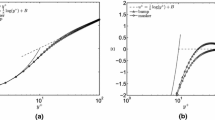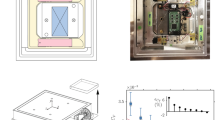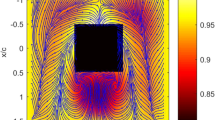Abstract
The present study is a part of a high-Reynolds-number experiment designed to establish a reliable data base helping to improve RANS turbulence models. In this work skin friction measurements were conducted in turbulent flows with significant pressure gradient using oil-film interferometry. The experiments were performed on a large-scale test model for three different flow velocities of 10, 23 and 36 m/s. Analysis of the skin friction distributions indicates that the state of the turbulent boundary layer remained out of equilibrium along the whole area investigated.
Access provided by CONRICYT-eBooks. Download conference paper PDF
Similar content being viewed by others
Keywords
- Skin Friction Distribution
- Large-scale Model Tests
- Clauser Chart Method
- RANS Computations
- Wall Shear Stress
These keywords were added by machine and not by the authors. This process is experimental and the keywords may be updated as the learning algorithm improves.
1 Introduction
The prediction of skin friction, heat transfer, and separation in turbulent flows with adverse pressure gradient (APG) is still associated with significant uncertainties when RANS-based computations are used. It is obvious that the modeling of the mean velocity and turbulent shear stress in these flows is often not satisfying. Although turbulent boundary layers with pressure gradients are still subject of research activities, suitable test cases for model validation are rare even in the low-speed flow regime [1, 2]. The reason for this is the diversity and complexity of test parameters involved, making investigations difficult. Up to now, the most important findings were made for simplified equilibrium boundary layers, which were initially defined by Clauser [3] as boundary layers with well defined simple pressure histories. Such equilibrium flows can be completely described by the non-dimensional pressure-gradient parameter \(\beta = \delta ^*(dp/dx)/\tau _{w}\), where dp / dx is the pressure gradient, \(\delta ^*\) is the displacement thickness, and \(\tau _{w}\) is the shear stress induced at the wall. In these flows, the turbulence and mean properties do not change with the running distance along the wall as long as the pressure gradient parameter remains constant and the net forces acting on the flow are zero.
Mellor and Gibson [4] extended the work of Clauser introducing an effective viscosity hypothesis on the basis of a classical boundary-layer model with two overlapping partitions, the wall layer and the defect layer. As result, they solved the equation of motion for a wide range of pressure gradients (\(-0.5 \le \beta \le \infty \)) and obtained a family of universal self-similar velocity profiles for flows in which \(\beta \) is held constant.
More recent studies (see e.g. [5]) showed, however, that such equilibrium flows are possible only in cases with zero pressure gradient or at zero wall-shear stress. Thus, most practical flows include non-equilibrium boundary layers, whose evolution is accompanied by relaxation processes and, therefore, can not be determined locally. Especially in the outer part of the boundary layer, the flow structure changes continuously due to the impact of history effects. Even at given pressure gradient, the resulting flow state can differ significantly depending on the pressure history. Strictly speaking, there is no chance to have an equilibrium state in turbulent flows with APG. However, it is well known that the flow close to the wall depends primarily on local parameters and does not really indicate pronounced history effects, so that some relations known for the locally determined flows could possibly be applied to describe the wall parameters.
The wall shear stress is one of the most important surface parameters in fluid dynamics, which is particularly valuable for the purpose of validation and seems to be a perfect indicator characterizing the flow directly in the proximity of the wall. The present study is a part of a high-Reynolds-number experiment [2] designed originally by means of numerical simulations with the purpose to realize a sufficiently thick naturally developed turbulent boundary layer subjected to an adverse pressure gradient, strong enough to have a distinct impact on the mean velocity without inducing flow separation. Wall shear stress distributions obtained in the present work were measured by oil-film interferometry (OFI), which is known for years as a reliable non-intrusive direct measurement technique [6,7,8]. The results measured are compared with values extracted indirectly from PIV and PTV velocity profiles using the Clauser chart method [9] as well as with numerical results predicted by RANS computations using DLR TAU Code [2].
2 Experimental Program and Test Setup
The present test campaign was conducted in the Eiffel type Atmospheric Wind Tunnel (AWM) of the Universität der Bundeswehr (UniBw) in Munich. The facility has a 22-m-long test section with a rectangular cross-section of \(2.0 \times 1.8\,\mathrm{m}^{2}\). The wind-tunnel model consists of two S-shaped deflection surfaces and a 4.0 m long flat plate mounted in between Fig. 1. The actual test area with a total length of 1.70 m begins at approximately \(x = 8.35\) m and covers only the rear part of the flat plate and the front half of the second S-shaped surface (red line). In this area, the boundary layer experienced initially a moderate favorable pressure gradient (FPG) and further downstream a strong adverse pressure gradient. It remains to be attached to the wall throughout the whole test area.
The experiments were performed at three different free-stream velocities \(U_{\infty }\) of 10, 23, and 36 m/s, resulting in Reynolds numbers Re\(_{\theta }\) of 8400, 16000, and 23000 at the upstream location \(x = 8.36\) m, which belongs to the oncoming “undisturbed” flow with a weak favorable pressure gradient. Related to the flow at the downstream end in the APG-zone (\(x = 9.95\) m), the given flow velocities correspond to Re\(_{\theta }\) of 15000, 28000, and 41000 [2].
Thus, the special challenge in the realization of OFI was the size of the test surface. The whole test area was split in several parts in order to reach a sufficient resolution of the interference pictures. Four optical windows available in the wind-tunnel side wall were used for the illumination and interference-image acquisition. To reduce the effort needed for large-scale experiments, explicitly commercial available components were used for the measurement setup. Five digital cameras NIKON D7100 were applied in parallel in order to ensure the shortest testing period possible. The whole test surface was covered on-site with a black reflective PVC film with a thickness of 0.1 mm. Two high-efficiency SOX-E 18W low-pressure sodium lamps combined pairwise with a white diffuse reflector (\(0.6 \times 0.6\,\mathrm{m}^2\)) were employed each as single monochromatic light sources. Three such diffuse reflectors were used in parallel for the illumination of the test surface. The individual light fields of each reflector enabled a field of view of maximum \(0.18 \times 0.25\,\mathrm{m}^2\) on the test surface for each camera. All cameras and light sources were mounted outside the wind tunnel.
The ELBESIL silicon oil was used in the present tests, and the appropriate viscosity was selected individually in the range from 5 to 50 mm\(^2\)/s (cSt) depending on the wall shear stress level expected. The oil viscosity was checked prior to the tests using a viscometer to minimize the uncertainty of the wall-shear-stress determination. Before flow start, the oil film was applied manually to the surface in thin stripes perpendicular to the flow direction at different x-locations with a distance of \({\approx }80-100\) mm to each other. Thus, during each single run multiple skin friction measurements in span-wise direction were done simultaneously at different x-locations. In this way, in several short subsequent runs, the entire 2-D skin friction distribution in the test area (1.70 m long and 0.16 m wide) could be measured for each of the free-stream conditions investigated.
The evaluation of the acquired interference pictures was analyzed by an in-house developed software tool enabling the calculation and visualization of skin-friction surface distributions. The automatic marker-based 3D-reconstruction of the images and the re-projection of the results onto the CAD model surface made a precise skin friction calculation possible on the basis of image sequences acquired simultaneously by different cameras. The full 3-D reconstruction for this large model configuration was absolutely necessary due to strong optical distortions observed in the images acquired by the commercial cameras applied.
3 Results and Discussion
The first example of wall-shear-stress measurements by oil film interferometry is presented in Fig. 2 demonstrating a \(\tau _w\)-distribution obtained at the test area at \(U_\infty =36\) m/s. This color plot is a 2D-spline interpolation of the experimental results. The distinct skin-friction variation along the x-axis due to the superimposed pressure gradient (flow is from left to right) indicates a quasi-two-dimensional flow over the test model. The weak span-wise variation of the wall shear stress at constant longitudinal locations can be specified to remain below ±4%, which is in the order of the uncertainty in shear stress values determined using image-based oil-film interferometry [7].
In order to have a better comparison with experimental results obtained earlier [2, 9], the OFI results presented and discussed below are obtained explicitly within the area with \(z = -0.01 \pm 0.002\) m. Figure 3 shows skin-friction distributions measured for all three freestream conditions as compared with results extracted from PIV and PTV velocity profiles [2, 9], as well as with results predicted numerically [2]. The abbreviations \(SSG/LRR-\omega \) and \(JHh-v2\) in the legends are identifiers of the turbulence models used in TAU computations (see [2] for details).
The comparisons show different degrees of matching in various pressure-gradient zones. In the upstream half of the test surface with ZPG/FPG (approx. \(x \le 9\) m), the skin friction coefficients measured by OFI are generally higher than the values obtained by PIV, PTV or RANS. In contrast, in the APG-zone further downstream, all results demonstrate a better agreement to each other.
As reported, the wall shear stress \(\tau _w\) obtained from the PIV and PTV data was extracted using the Clauser chart method. Even in the zone with APG, a thin log-law region was observed in the velocity profiles, where \(u^+\) could be fitted by the corresponding equation. For the PTV data, the relation \(u^+ = y^+\) was additionally used in the range \(2\le y^+ \le 5\) for the evaluation in the viscous sublayer.
The important fitting parameters for the Clauser-chart method are the von-Karman constant \(\kappa \), the integration constant B, and the relevant interval \(y_\mathrm {min}^+<y^+<y_\mathrm {max}^+\) in which the data was fitted. In the APG region, the velocity profiles measured suggest \(y_\mathrm {min}^+=40\) and \(y_\mathrm {max}^+=100\) for \(U_\infty =10 \,\mathrm {m/s}\), and \(y_\mathrm {min}^+=65\) and \(y_\mathrm {max}^+=140\) for \(U_\infty =23\,\mathrm {m/s}\). In the shown results, the Clauser chart was performed using the classical values \(\kappa = 0.41\) and \(B = 5.0\) according to Coles [10], which were held constant independent of the local pressure gradient.
The reason for the significant deviations of the results obtained in the ZPG/FPG regions, which are definitely beyond the OFI tolerance limits, is not clear at the moment. On the one hand, the results of PIV and PTV measurements, used for validation of RANS computations in the previous steps of this study, play an important role for the evaluation of the common results delivering high-resolution velocity profiles. On the other hand, the skin-friction data obtained indirectly from velocity profiles could be very prone to errors, especially in cases with strong pressure gradients. The effects of inaccuracies in the determination of the absolute wall position and of the friction velocity using the Clauser-chart method in such flows was impressively demonstrated e.g. by Örlü et al. [11]. Therefore, it can be assumed that the discrepancies in skin friction values revealed have the same reason.
Normalized skin friction distributions over \(\beta \) obtained by different methods and predicted for equilibrium flow conditions in [4]
Comparison of normalized skin friction distributions obtained by different methods and predicted for equilibrium flow conditions in [4]
Figure 4 demonstrates normalized skin-friction distributions presented over the dimensionless pressure gradient parameter \(\beta _{SSG}\) in order to study the effect of pressure gradient on the skin friction distribution. The index SSG indicates that \(\beta _{SSG}\) was predicted numerically by RANS-computations [2] using the \(SSG/LRR-\omega \) turbulence model. Additionally to the experimental and numerical results, the theoretical curve \(C_f/C_{f1} = f(\beta )\) for the locally equilibrium boundary layer (red line) is presented in the plot as predicted in [4]. The reference values \(C_{f1}\) were determined for each case by fitting to the theoretical dependencies at most upstream locations, where the effects of pressure gradients were lowest. The same results are presented again in Fig. 5, showing the normalized skin friction distributions over the longitudinal coordinate x.
The first impression from these both figures is that the normalized data obtained by the different techniques showed only minor differences. This can be an indication that the discrepancies between the OFI data and RANS computations observed in Fig. 3 are resulting mainly from differences already existing in the incoming flow upstream of the interaction zone. Even at the most upstream location, where the pressure gradient effects appeared to be negligible, the incoming-flow state seems to be different in numerical simulations and in experiments.
The next finding to be noted is the clear difference between the common dependency \(C_f/C_{f1} = f(\beta )\) and the equilibrium-flow relation known from [4]. The observed dependency is slowly approaching the equilibrium state with increasing streamwise distance along the test surface, indicating a non-equilibrium boundary layer, whose evolution is accompanied by relaxation processes instead of being determined locally.
4 Conclusions
The oil-film interferometry (OFI) is used in the present work to investigate the effects of pressure gradients on the wall shear stress variation in turbulent boundary layers. The measured results are compared with values extracted indirectly from PIV and PTV velocity profiles using the Clauser chart method, as well as with numerical results predicted by RANS computations. The outcomes of this study can be summarized as follows:
-
A cost efficient setup for oil-film interferometry was used to determine the wall shear stress distribution on a large-scale model at low-speed flow conditions;
-
Observed skin-friction variations along the x-axis are plausible due to the superimposed pressure gradient and indicate a well developed 2-D flow over the test model. The weak span-wise variation of the wall shear stress at constant longitudinal locations was specified to be in the order of the measurement uncertainty;
-
Comparisons of absolute skin-friction levels obtained by the different methods reveal that, especially in the FPG-zone, the values measured by OFI are generally higher than the ones obtained using PIV. It is most likely that these discrepancies are caused by an erroneous wall stress estimation using the Clauser-chart method expected in flows with complex pressure history;
-
In contrast, the normalized skin-friction data obtained by different techniques showed only minor differences. This can be an indication that the discrepancies between the OFI data and RANS computations are resulting from differences existing already in the incoming flow upstream of the interaction zone;
-
Results reveal a clear deviation of the normalized skin-friction distribution over the test model from the one predicted according to the equilibrium flow theory. Especially in the FPG region the departure of the flow from equilibrium is significant. This is an evidence that the investigated flow is mainly a non-equilibrium boundary layer, whose evolution is accompanied by relaxation processes instead of being determined locally.
References
Knopp, T., Schanz, D., Schröder, A., Dumitra, M., Kähler, C.J.: Experimental investigation of a turbulent boundary layer flow at high Reynolds number without and with separation using PIV, CFD and Experiment. Integration of Simulation Workshop, Göttingen, Germany, 05–06 Apr 2011
Knopp, T., Novara, M., Schanz, D., Schülein, E., Schröder, A., Reuther, N., Kähler, C.J.: A new experiment of a turbulent boundary layer flow at adverse pressure gradient for validation and improvement of RANS turbulence models. In: New Results in Numerical and Experimental Fluid Mechanics, Contributions to the 20th STAB/DGLR Symposium Braunschweig, Germany
Clauser, F.: Turbulent boundary layers in adverse pressure gradients. J. Aerosp. Sci. 21(2), 91–108 (1954)
Mellor, G.L., Gibson, D.M.: Equilibrium turbulent boundary layers. J. Fluid Mech. 24(2), 225–253 (1966)
Skote, M., Henningson, D.: Direct numerical simulation of a separated turbulent boundary layer. J. Fluid Mech. 471, 107–136 (2002)
Tanner, L.H., Blows, L.G.: A study of the motion of oil films on surfaces in air flow, with application to the measurement of skin friction. J. Phys. E: Sci. Instrum. 9(3), 194 (1976)
Naughton, J.W., Sheplak, M.: Modern developments in shear-stress measurement. Prog. Aerosp. Sci. 38, 515–570 (2002)
Schülein, E.: Skin friction and heat flux measurements in shock/boundary layer interaction flows. AIAA J. 44(8), 1732–1741 (2006)
Reuther, N., Scharnowski, S., Hain, R., Schanz, D., Schröder, A., Kähler, C.J.: Experimental investigation of adverse pressure gradient turbulent boundary layers by means of large-scale PIV. In: 11th International Symposium on Particle Image Velocimetry—PIV15, Santa Barbara, California, 14–16 Sept 2015
Coles, D.: The law of the wake in the turbulent boundary layer. J. Fluid Mech. 1, 191–226 (1956)
Örlü, R., Fransson, J.H.M., Alfredsson, P.H.: On near wall measurements of wall bounded flows. The necessity of an accurate determination of the wall position. Prog. Aerosp. Sci. 46(8), 353–387 (2010)
Author information
Authors and Affiliations
Corresponding author
Editor information
Editors and Affiliations
Rights and permissions
Copyright information
© 2018 Springer International Publishing AG
About this paper
Cite this paper
Schülein, E., Reuther, N., Knopp, T. (2018). Optical Skin Friction Measurements in a Turbulent Boundary Layer with Pressure Gradient. In: Dillmann, A., et al. New Results in Numerical and Experimental Fluid Mechanics XI. Notes on Numerical Fluid Mechanics and Multidisciplinary Design, vol 136. Springer, Cham. https://doi.org/10.1007/978-3-319-64519-3_9
Download citation
DOI: https://doi.org/10.1007/978-3-319-64519-3_9
Published:
Publisher Name: Springer, Cham
Print ISBN: 978-3-319-64518-6
Online ISBN: 978-3-319-64519-3
eBook Packages: EngineeringEngineering (R0)









